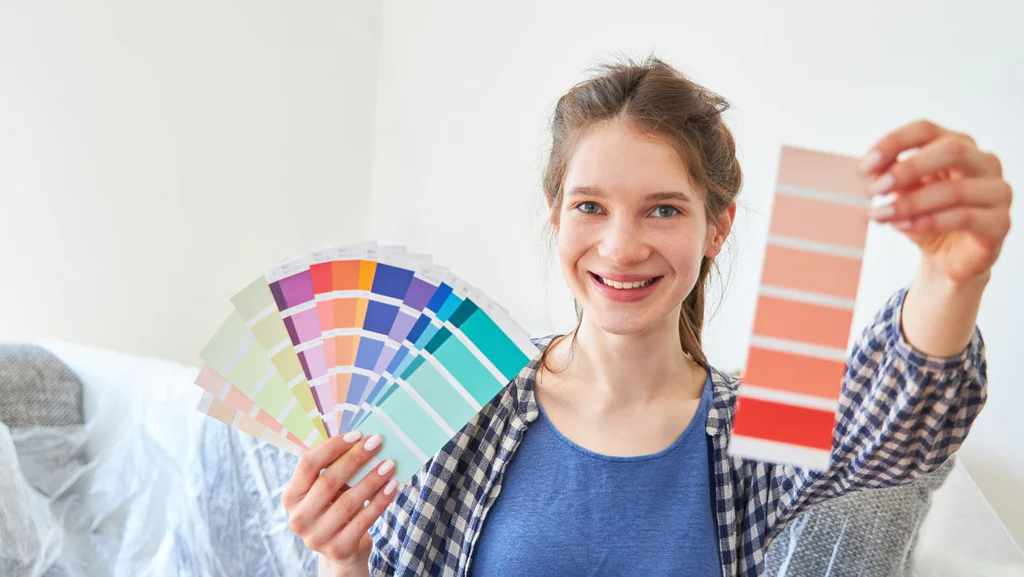Are you starting an interior design project and trying to decide on the perfect color scheme? Whether you're working on your home, office, or a commercial space, choosing the right colors is a crucial step in creating a beautiful and functional environment. With so many shades of each color and endless combinations between primary, secondary, and tertiary hues, it's easy to feel overwhelmed. But don't worry—this guide will walk you through some essential tips that will simplify the process and help you create a visually appealing space.

What is Color Theory?
Color theory is a fascinating area that explores how colors interact and affect our perception. It covers everything from the color wheel to the emotional responses different colors can evoke. Colors have the power to inspire, relax, and even influence our moods. Understanding concepts like hue, saturation, and brightness helps in using color effectively in design, art, and marketing. Applying these principles can lead to more engaging and impactful visual designs.

Color Theory Basics for Interior Design
- The Color Wheel: The color wheel is a fundamental tool used by designers to understand and organize colors. It consists of 12 colors arranged in a circle. Red, yellow, and blue are the primary colors, while green, orange, and purple are secondary. Tertiary colors are created by mixing primary and secondary ones.
- Color Harmony: This refers to how colors work together in a space. There are four main types: monochromatic, complementary, analogous, and triadic. Monochromatic uses different tones of the same color, complementary uses opposite colors on the wheel, analogous uses adjacent colors, and triadic combines three equally spaced colors.
- Mood & Emotion: Different colors can influence emotions. Warm tones like red, orange, and yellow create a cozy feel, while cool tones like blue and green promote calmness. Bright colors bring energy, while muted tones add sophistication.
- Lighting: Lighting plays a big role in how colors appear. Natural light makes colors look vibrant, while artificial light can alter their tone. Always test colors in the actual lighting conditions of the room.
- Texture: Textures also affect how colors are perceived. Rough textures can give a natural feel, while smooth ones look sleek and modern. They also influence how light reflects off surfaces, changing the color’s appearance.

Tips for Using Color Theory to Choose a Color Palette
- Start with a color you love. It could be from a piece of furniture, artwork, or even a favorite item in your home.
- Use the color wheel to find complementary or analogous colors. For example, if you have a red pattern, choose a complementary color like green to balance it out.
- Try the "dark to light" approach vertically. Use darker shades on the floor, medium on the walls, and lighter on the ceiling to make the space feel larger.
- Don’t shy away from neutrals like gray or beige. They’re versatile and pair well with bold accents.
- Follow the “60-30-10†rule: 60% main color, 30% secondary, and 10% accent. This creates a balanced and cohesive look.
- Combine warm and cool tones for a dynamic effect. For instance, pairing soft grays with warm wood tones can add depth and balance.
- Monochromatic schemes work great in small spaces. Try using different shades of one color to create a subtle yet stylish look.


Choosing the right color palette might seem challenging, but with a little knowledge and practice, it becomes much easier. Aim for a cohesive look that still allows for contrast and personality. Keep things simple, follow basic guidelines, and let your personal style shine through. After all, your space should reflect who you are and how you want to feel every day.
Fiber Coupled Lasers
Fiber Coupled Laser Module
All series CNI Laser modules can be fiber coupled with different core diameter MM fiber or SM fiber. You have to refer to the detailed specs of each laser modules (such as power, stability, noise, size, etc) to decide which one is suitable for your application. We would like to do the coupling job for you.

Fiber Coupled Integrated Electronics Laser System
The FC series (Fiber Coupled Laser System) integrates Laser Diode, laser cavity, fiber coupled optics, laser power supply, LD current and crystal temperature control into ONE box. The power is available for 1mW-100W with different dimensions. The characteristics of compact design and convenient functions make it very suitable for pumping, scientific research, industrial and medical applications.
 |
 |
 |
|
FC-X Low Power Levels |
FC-W-A/ B 50W |
FC-W-H 50-100W |
Multi-wavelength Fiber Coupled Laser
Special offer multi-wavelength fiber coupled laser system are designed with integrated electronics and easy operation. 2~6 wavelengths can be combined into one box. USB or RS232 connector is optional. Wavelengths are available for UV-Visible-IR range, lasers include diode and DPSS lasers. The multi-wavelength lasers are widely used for medical, biomedical, and industrial application, etc.

Even Beam Fiber Coupling
CNI can supply the even beam distribution of laser modules and laser systems, features a flat beam profile with different wavelengths. They are suitable for the fields of medical treatment, ultraviolet curing, fluorescent detection, criminal investigation and scientific research.


Round Even Beam
Square Even Beam
 |
 |
|
Fiber |
Fiber Collimator |
|
Single-mode fiber with core diameter 4-9 μm Multi-mode fiber with core diameter 50-1000 μm |
Used to collimate the beam at the end of fiber Focus adjustable collimator optional |
Multiwavelength Laser,Fiber Coupled,Red Fiber Coupled Led, Multi-Wavelength Laser
Changchun New Industries Optoelectronics Technology Co., Ltd. , https://www.cnioptics.com